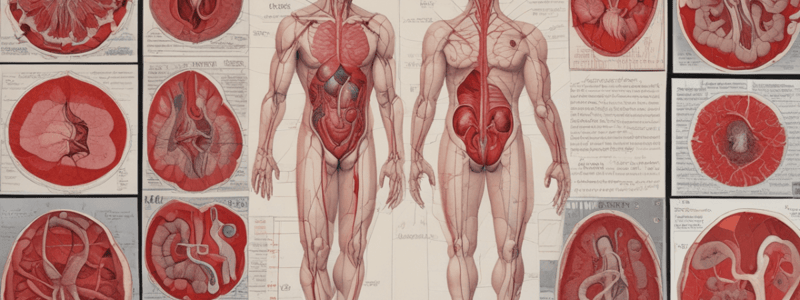Podcast
Questions and Answers
Why would the removal of large quantities of blood have negative effects on a patient?
Why would the removal of large quantities of blood have negative effects on a patient?
- It would improve the immune response.
- It would reduce the oxygen-carrying capacity of the blood. (correct)
- It would increase the risk of heart failure.
- It would lead to an excess of red blood cells.
Which physiological component is more essential to overall bodily function, the heart or the capillaries?
Which physiological component is more essential to overall bodily function, the heart or the capillaries?
- Both are equally important for different functions.
- The capillaries, as they allow for nutrient exchange with tissues. (correct)
- Neither is essential for overall bodily function.
- The heart, because it pumps blood throughout the body.
What is a likely reason for experiencing swelling in the feet and ankles after sitting for extended periods?
What is a likely reason for experiencing swelling in the feet and ankles after sitting for extended periods?
- Increased blood flow due to prolonged sitting.
- Decreased heart rate from sitting for too long.
- Fluid accumulation due to lack of movement and gravity. (correct)
- Improved circulation in the lower extremities.
Why would first babies rarely be affected by haemolytic disease of the newborn if the mother has Rh-negative blood?
Why would first babies rarely be affected by haemolytic disease of the newborn if the mother has Rh-negative blood?
In which scenario would haemolytic disease of the newborn be more likely to occur?
In which scenario would haemolytic disease of the newborn be more likely to occur?
Why does the blood need to be pumped twice for each complete circulation through the body and lungs?
Why does the blood need to be pumped twice for each complete circulation through the body and lungs?
What is the function of the atrioventricular valves in the heart?
What is the function of the atrioventricular valves in the heart?
Why is blood red?
Why is blood red?
What causes someone with an infected toe to experience a lump in their groin?
What causes someone with an infected toe to experience a lump in their groin?
How is oxygen carried in the blood?
How is oxygen carried in the blood?
What is the purpose of semilunar valves in the heart?
What is the purpose of semilunar valves in the heart?
During exercise, what changes occur in blood flow?
During exercise, what changes occur in blood flow?
'Circulation' can be defined as:
'Circulation' can be defined as:
What is the main function of the lymphatic system?
What is the main function of the lymphatic system?
How does the structure of a red blood cell relate to its function?
How does the structure of a red blood cell relate to its function?
Why were early attempts at blood transfusion risky and often fatal?
Why were early attempts at blood transfusion risky and often fatal?
Which organ is responsible for the sequence of events in blood clotting?
Which organ is responsible for the sequence of events in blood clotting?
How does an artery's structure contribute to its function?
How does an artery's structure contribute to its function?
In the ABO blood group system, which antigen is present in type A blood?
In the ABO blood group system, which antigen is present in type A blood?
'Bad blood' was once believed to cause disease. What common medical practice was associated with this belief?
'Bad blood' was once believed to cause disease. What common medical practice was associated with this belief?
Why must the donor's ABO blood group match the receiver's when giving plasma in a transfusion?
Why must the donor's ABO blood group match the receiver's when giving plasma in a transfusion?
What is the primary function of the heart?
What is the primary function of the heart?
Flashcards are hidden until you start studying




